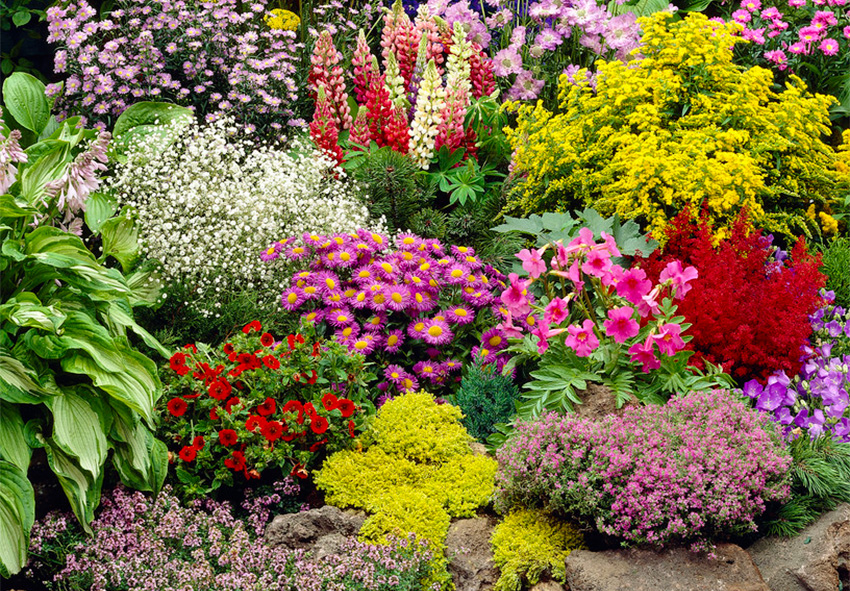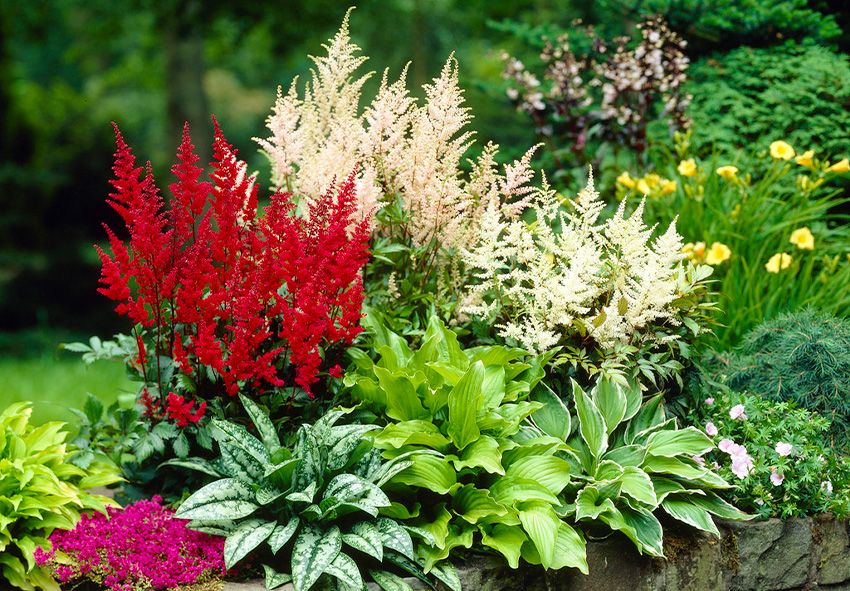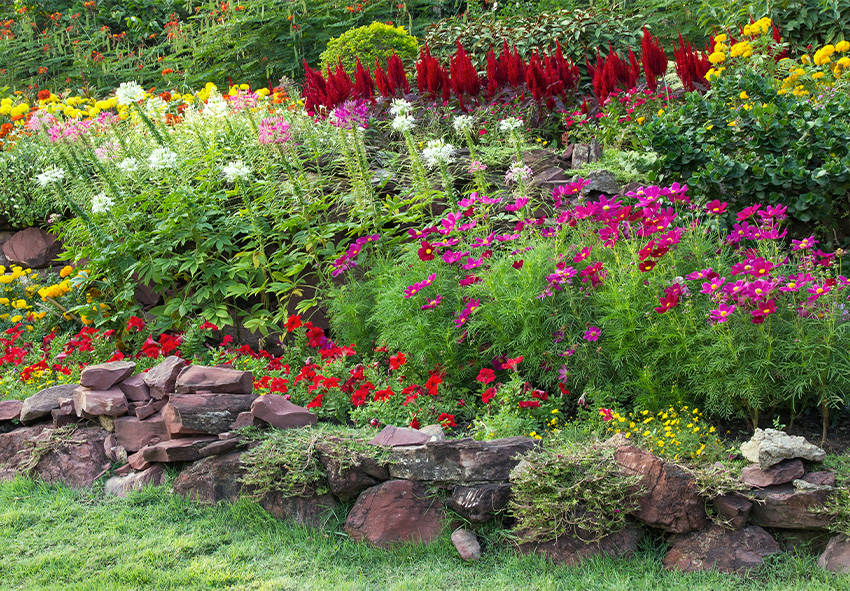Astilbe, a popular perennial flower, is cherished by gardeners for its elegant feathery plumes and lush foliage. Known for its ability to thrive in shaded areas, Astilbe is a versatile plant that can enhance the beauty of any garden. In this article, we will explore the characteristics of Astilbe, its benefits, and why it should be a staple in your garden design.
What is Astilbe?

Astilbe, also known as False Goat’s Beard or False Spirea, is a genus of around 18 species of rhizomatous flowering plants. Native to Asia and North America, these plants are renowned for their vibrant, plume-like flowers that bloom in shades of pink, red, white, and purple. The foliage, typically fern-like and deep green, can also vary in color, adding texture and interest to garden beds.
Benefits of Using Astilbe in Gardens
Astilbe offers several advantages that make it a valuable addition to any garden design:
- Shade Tolerance: One of the most significant benefits of Astilbe is its ability to thrive in shady conditions where many other flowering plants struggle. This makes it an excellent choice for woodland gardens or areas under trees.
- Low Maintenance: Astilbe is a low-maintenance plant that requires minimal care once established. It is relatively pest and disease-resistant, reducing the need for chemical interventions.
- Long Blooming Period: Astilbe blooms from late spring to early summer, with some varieties extending their flowering period into late summer. This long blooming period ensures continuous color in the garden.
- Attracts Pollinators: Astilbe flowers are attractive to bees, butterflies, and other pollinators, promoting biodiversity in your garden.
By incorporating Astilbe into your garden design, you can enjoy a lush, colorful, and low-maintenance landscape that thrives in the shade and adds year-round interest to your outdoor space.
Incorporating Astilbe in Garden Design
Astilbe thrives in specific conditions that maximize its growth and flowering potential. Understanding these requirements will help you cultivate healthy, vibrant plants. Astilbe prefers rich, organic soil that retains moisture yet drains well. A slightly acidic to neutral pH (between 6.0 and 7.0) is ideal. To enhance soil fertility and drainage, incorporate organic matter such as compost or well-rotted manure before planting. While Astilbe is renowned for its shade tolerance, it can also thrive in partial sun. Ideally, Astilbe should be planted in areas that receive morning sun and afternoon shade. Too much direct sunlight can scorch the leaves and reduce flowering, whereas deep shade may lead to fewer blooms. Consistent moisture is crucial for Astilbe. The soil should be kept evenly moist, especially during dry spells. Mulching around the plants helps retain soil moisture and keeps the roots cool. Regular watering is particularly important during the plant’s active growing and blooming periods.
Choosing the Right Varieties

Selecting the appropriate Astilbe varieties for your garden depends on your design goals and the specific conditions of your planting site. Here are a few popular varieties:
| Astilbe Variety | Preferred Climate | Pollinator Attraction | Shade Tolerance | Maintenance | Soil Conditions |
| Astilbe ‘Fanal’ | Cool to moderate | High | High | Low | Moist, well-drained |
| Astilbe ‘Visions’ | Moderate | Moderate | High | Low | Moist, well-drained |
| Astilbe ‘Bridal Veil’ | Cool to moderate | Moderate | High | Low | Moist, well-drained |
| Astilbe ‘Purple Candles’ | Moderate to warm | High | Moderate | Low | Moist, well-drained |
Designing with Astilbe
Astilbe’s versatile nature makes it suitable for various garden designs. Here are some tips for incorporating Astilbe into different garden styles:
- Cottage Gardens: Astilbe’s lush foliage and plume-like flowers fit perfectly into cottage gardens. Plant them in clusters for a naturalistic look, alongside other shade-loving perennials like hostas and ferns.
- Modern Landscapes: For a more structured look, use Astilbe in geometric patterns or as a border plant. Pair it with ornamental grasses and sleek, minimalist hardscaping elements.
- Mixed Perennial Beds: Astilbe adds texture and color to mixed perennial beds. Use it as a mid-height filler between taller plants and groundcovers to create layers of interest.
- Water Features: Given its preference for moist soil, Astilbe is ideal for planting near water features such as ponds or streams. Its reflective blooms can enhance the visual appeal of these areas.
By understanding the ideal growing conditions, selecting the right varieties, and strategically placing Astilbe in your garden design, you can create a stunning landscape that showcases these beautiful, shade-loving perennials.
Astilbe in Shade Gardens

Astilbe is an exceptional choice for shade gardens due to its unique attributes that thrive in low-light conditions. Its ability to produce vibrant, feathery blooms in various shades of pink, red, white, and purple makes it a standout plant even in the shadiest corners of your garden. The fern-like foliage adds texture and depth, enhancing the overall aesthetic appeal. Additionally, Astilbe’s preference for moist, well-drained soil aligns perfectly with the conditions typically found in shaded areas, where the soil tends to retain more moisture.
Companion Plants for Astilbe in Shade Gardens
To create a lush and dynamic shade garden, consider pairing Astilbe with other shade-loving plants that complement its foliage and flower structure. Here are some excellent companion plants:
- Hostas: Known for their large, attractive leaves, hostas provide a beautiful contrast to Astilbe’s delicate plumes. They come in various shades of green, blue, and variegated patterns, adding visual interest.
- Ferns: Ferns, with their intricate fronds, blend seamlessly with Astilbe’s feathery foliage. Together, they create a layered, woodland feel that’s both soothing and visually appealing.
- Bleeding Hearts (Dicentra): The heart-shaped flowers of bleeding hearts add a whimsical touch to shade gardens. Their pink or white blooms appear in early spring, complementing Astilbe’s later blooming period.
- Solomon’s Seal (Polygonatum): This plant’s arching stems and hanging white flowers offer a graceful contrast to Astilbe’s upright blooms. It’s an excellent choice for adding height and movement to the garden.
Creating a Balanced Shade Garden
Designing a visually appealing shade garden with Astilbe involves thoughtful planning and plant placement. Use a variety of plant heights to create depth and dimension. Place taller plants like ferns and Solomon’s Seal towards the back or center, with medium-height plants like Astilbe in the middle, and low-growing groundcovers like Heuchera at the front. Choose plants with complementary foliage and flower colors. For example, the deep green leaves of hostas can enhance the bright blooms of Astilbe, while the dark purple leaves of Heuchera provide a striking backdrop.
Combine plants with different leaf textures to add visual interest. The broad leaves of hostas, the fine fronds of ferns, and the feathery plumes of Astilbe create a rich tapestry of textures. Select plants that offer interest in different seasons. While Astilbe blooms in late spring to early summer, bleeding hearts and hellebores provide early spring color, and hostas and ferns maintain their beauty through summer and fall. Ensure that all companion plants have similar moisture requirements to Astilbe. Look for more information about it in our full guide for Astilbe. Consistent watering and mulching can help maintain the moist, well-drained soil that shade-loving plants prefer.
Astilbe as Perennial Flowers in Landscaping

Astilbe is a perennial favorite in landscaping due to its ability to provide continuous interest throughout the growing season. In spring, its lush, fern-like foliage emerges, creating a fresh, green backdrop in the garden. As summer approaches, Astilbe bursts into bloom with feathery plumes in shades of pink, red, white, and purple, adding vibrant color to the landscape. Even after the flowers fade, the seed heads and foliage maintain their structure and interest into the fall. During winter, the dried flower stalks and seed heads can add a touch of texture and contrast to the winter garden, particularly if left standing with a dusting of snow.
Using Astilbe in Borders and Edges
Astilbe is an excellent choice for garden borders and edges due to its uniform growth habit and striking blooms. Plant Astilbe in neat, uniform rows along pathways or garden beds to create a formal, structured look. The symmetrical arrangement of their plumes adds elegance and definition to the garden. Combine Astilbe with other border plants such as hostas, ferns, and daylilies to create a diverse and visually appealing border. The varying textures and colors will provide a dynamic display throughout the growing season.
Use dwarf Astilbe varieties to edge garden paths. Their compact size and vibrant blooms will define the walkway while adding a burst of color and interest. Astilbe can be used to transition between different garden areas, such as from a shaded woodland garden to a sunnier flower bed. Their shade tolerance makes them versatile in these transition zones.
Astilbe in Mixed Perennial Beds
Integrating Astilbe into mixed perennial beds can enhance the visual appeal and diversity of your garden. Here are some strategies for effective integration:
- Color Harmony: Select Astilbe varieties that complement the colors of other perennials in the bed. For example, pair white Astilbe with purple coneflowers and pink phlox for a harmonious color palette.
- Height Variation: Use Astilbe to add height and depth to mixed perennial beds. Plant taller varieties towards the back and shorter varieties in the front to create a tiered effect that draws the eye upwards.
- Seasonal Succession: Plan your perennial bed to ensure continuous blooms throughout the growing season. Astilbe’s mid-summer blooms can be complemented by early spring bulbs like tulips and late summer flowers like asters.
- Maintenance Considerations: Astilbe is relatively low maintenance, making it a great companion for other low-maintenance perennials. Ensure that all plants in the mixed bed have similar water and soil requirements to simplify care and upkeep.
By incorporating Astilbe into your garden design as perennial flowers, you can enjoy their vibrant blooms, lush foliage, and seasonal interest year-round.
Conclusion
Incorporating Astilbe into your garden design can bring a new level of beauty and diversity to your outdoor space. With their vibrant blooms, lush foliage, and versatility, Astilbe plants are perfect for a variety of garden styles, from formal borders to mixed perennial beds and shade gardens.
Whether you are looking to add seasonal interest, define garden edges, or create a stunning shade garden, Astilbe can enhance the overall aesthetic and health of your landscape. So, why not give Astilbe a try? With the tips and ideas provided in this guide, you’ll be well-equipped to incorporate these beautiful perennials into your garden design, enjoying their charm and elegance for years to come. Happy gardening!
Frequently Asked Questions (FAQs) about Astilbe in Garden Design
1. What are the ideal growing conditions for Astilbe?
Astilbe thrives in moist, well-drained soil and prefers partial to full shade. It is also important to ensure the soil is rich in organic matter and remains consistently moist, especially during dry periods.
2. How often should I water my Astilbe plants?
Astilbe requires regular watering, especially during dry spells. The soil should be kept consistently moist but not waterlogged. Mulching around the plants can help retain moisture and reduce the need for frequent watering.
3. What are some good companion plants for Astilbe in a shade garden?
Astilbe pairs well with other shade-loving plants such as hostas, ferns, heucheras (coral bells), and Solomon’s seal. These plants complement Astilbe’s texture and color, creating a lush and vibrant shade garden.
4. Can I order Holland Astilbe from your online store?
Yes, you can! Our online store Dutch-bulbs.com offers a wide selection of Astilbe plants, including different varieties and colors. We take pride in providing top-quality plants that are carefully cultivated and shipped with care to ensure they reach you in perfect condition.
5. How do I maintain Astilbe plants throughout the year?
Astilbe is low-maintenance. In spring, remove any dead foliage from the previous year. During the growing season, keep the soil moist and apply a balanced fertilizer. In the fall, after the blooms have faded, you can cut back the flower stalks. Mulching before winter can protect the roots from freezing temperatures.
Published: 28.05.2024
